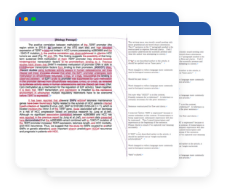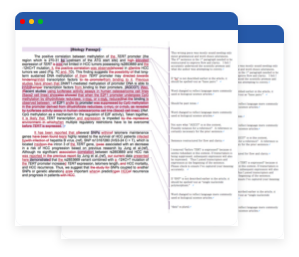副词和状语
副词是用来描述动词、形容词、其他副词或整个句子的词。副词通常是以ly结尾的单词。在很多情况下,副词是在对应的形容词后面加ly构成的 (例如, beautiful → beautifully).
副词可以用来描述某事是如何做的,也可以用来说明某物有多少。使用副词能够使句子具有更详细的描述。
副词包括五种类型 : 时间, 方式, 程度, 地点, 频率。 每种副词分别用来描述某事什么时候发生、如何发生、发生到什么程度、在哪里发生、多么频繁地发生。
副词的种类
| 副词种类 | 副词的作用 | 副词示例 |
|---|---|---|
| 时间副词 |
提供动词何时发生的信息 |
never, lately, just, always, recently, during, yet, soon, sometimes, usually, so far |
| 方式副词 |
提供动词如何发生的信息 |
carefully, softly, slowly, quickly, sadly, calmly, politely, loudly, kindly, lazily |
| 程度副词 |
提供动词、形容词或其他副词的程度水平或强度 |
almost, quite, nearly, too, enough, just, hardly, simply, so |
| 地点副词 |
提供动词发生的地点信息 |
here, there, nowhere, everywhere, out, in, above, below, inside, outside, into |
| 频率副词 |
提供动词的频率信息 |
never, always, rarely, sometimes, normally, seldom, usually, again |
副词与动词连用
副词修饰动词时,可以用来描述动作是如何发生的。这时,副词通常出现在它所修饰的动词的前面或后面。
- Example
- He runs quickly to get to school.
在上例中,副词“quickly”用来描述他如何跑。
- Example
- She carefully took out a book from the shelf.
在上例中,副词“carefully”用来描述她如何拿出一本书。
在上面两个句子中的副词“quickly”和“carefully”都描述了动作是如何进行的,即他是怎么跑的,以及她是怎么把书拿出来的。
副词与形容词连用
副词修饰形容词时,可以修饰形容词的强度水平。
- Example
- I will be slightly late to the party.
上例中的副词“slightly”修饰聚会迟到的程度。
- Example
- You've done a pretty good job.
上例中的副词“pretty”修饰工作做得有多么好。上面两个例子中的副词“slightly”和“pretty”都是用来修饰形容词,描述某事发生的程度。
副词与副词连用
副词可以修饰其他副词,用以强化副词的程度。在大多数情况下,修饰另一个副词的副词应该放在它所修饰的副词的前面。
- Example
- She finished the job extremely quickly.
在上例中,副词“extremely”用来修饰另一个副词“quickly”。
- Example
- Don't drive your car so fast.
在上例中,副词“so”修饰另一个副词“fast”。在上面的两个例子中,“extremely”和“so”都是对放在它们后面的那个副词进行修饰,描述被修饰副词的强烈程度。
副词短语
副词短语是一组起副词作用的词。在很多情况下,副词是一个单词,而副词短语则由多个单词组成,为动词、形容词、其他副词或整个句子增加更多信息。即使在构成副词短语的一组词中不包含副词,副词短语也能起到副词的作用。副词短语通常包含介词。
- 副词
- I will sit here silently.
- 副词短语
- I will stay here in silence.
- 副词
- She will drop by later.
- 副词短语
- She will drop by when she gets off from work.
- Example
- I went to the store to get some groceries.
在上例中,副词短语“to get some groceries”用来描述去商店的目的。
- Example
- He parked his car over there near the park.
在上例中,副词短语“over there near the park”用来描述他停车的地方。
显示比较程度
副词的拼写形式可以发生改变,用来表示比较的程度,就像形容词拼写形式发生改变能表示比较的程度一样 (busy, busier, busiest)。
简单副词
当一个副词与其对应的形容词具有相同的拼写形式时,这种副词称为简单副词。简单副词的比较级和最高级形式与其对应的形容词的比较级和最高级形式相同。
| 副词的原级 | 副词的比较级 | 副词的最高级 |
|---|---|---|
|
fast |
faster |
fastest |
|
close |
closer |
closest |
|
hard |
harder |
hardest |
|
free |
freer |
freest |
|
right |
righter |
rightest |
以ly结尾的副词
对于以“ly”结尾的副词,它的比较级和最高级须分别使用“more”和“most”。
| 副词的原级 | 副词的比较级 | 副词的最高级 |
|---|---|---|
|
brightly |
more brightly |
most brightly |
|
clearly |
more clearly |
most clearly |
|
seriously |
more seriously |
most seriously |
|
faithfully |
more faithfully |
most faithfully |
|
promptly |
more promptly |
most promptly |
单音节副词
单音节副词的比较级形式是在动词词根的末尾放置“er”。单音节副词的最高级形式是在动词词根的末尾放置“est”。
| 副词的原级 | 副词的比较级 | 副词的最高级 |
|---|---|---|
|
long |
longer |
longest |
|
high |
higher |
highest |
|
near |
nearer |
nearest |
|
early |
earlier |
earliest |
|
wide |
wider |
widest |
不规则的副词比较形式
副词也有一些不规则的比较级和最高级形式,如下表所示。
| 副词的原级 | 副词的比较级 | 副词的最高级 |
|---|---|---|
|
well |
better |
best |
|
bad |
worse |
worst |
|
much |
more |
most |
|
far |
farther |
farthest |
副词的位置
一般来讲,副词应该放在它所修饰的词的前面或后面(或尽可能靠近)。
副词可以放在以下三个位置 :
1)句子开头;
2)主要动词前面;
3)主要动词后面或句末。
在很多情况下,副词可以放在上述三个位置中的任何一个,而不会影响句子的意思。
- Example
-
Quickly, she disappeared into the crowd.
She quickly disappeared into the crowd.
She disappeared into the crowd quickly.
- Example
-
Cheerfully, I said goodbye to my friend.
I cheerfully said goodbye to my friend.
I said goodbye to my friend cheerfully.
不管副词“quickly”和“cheerfully”放在哪里,上面这几句话的意思都相同。在这种情况下,副词的位置仅反映了文体风格的选择。
然而,在某些情况下,副词位置不当,会完全改变句子的意思。
- Example
-
I only want to go to the mall.
I want to go to the mall only.
上述两个句子具有完全不同的意思。第一句的意思是“我想做的一切就是去购物中心”,而第二句的意思是“我想去的唯一地方就是购物中心”。
- Example
-
Especially, you should treat her nicely.
You should especially treat her nicely.
You should treat her especially nicely.
在上例的第一句中,副词“especially”强调主语“you”。而在第二句中,副词强调应该善待她。在第三句中,“especially”修饰副词“nicely”。最好把副词放在它所修饰的动词旁边,以避免这些潜在的语意含糊不清问题。
副词与不及物动词连用
当副词与不及物动词连用时,在某些情况下,副词须放在不及物动词后面,以避免句子听起来别扭。
- Awkward
- He softly spoke.
- Correct
- He spoke softly.
- Awkward
- The children loudly laughed.
- Correct
- The children laughed loudly.
但是,对于never、always、often、rarely、seldom等频率副词,它们应当放在不及物动词的前面。
- Incorrect
- You should come always home after school.
- Correct
- You should always come home after school.
- Incorrect
- He calls rarely me.
- Correct
- He rarely calls me.
常见的副词错误
小提示:在完成草稿前,可使用语法检查器标示并修正频率副词位置错误,可让文章更流畅专业。
表示频率的副词通常应当放在主要动词的前面。
- Incorrect
- She cleans hardly ever her room.
- Correct
- She hardly ever cleans her room.
- Incorrect
- I take a bath always after dinner.
- Correct
- I always take a bath after dinner.
表示方式的副词通常应当放在句末。
- Incorrect
- She loudly spoke.
- Correct
- She spoke loudly.
- Incorrect
- He folded neatly his shirt.
- Correct
- He folded his shirt neatly.
副词“enough”总是需要跟在它所修饰的词后面。
- Incorrect
- This bag is enough big.
- Correct
- This bag is big enough.
- Incorrect
- I'm not enough strong to do this.
- Correct
- I'm not strong enough to do this.
Good与 Well的区别
“good”是形容词。“well”是副词。这两个词经常被误用。
- Incorrect
- I play the piano good.
- Correct
- I play the piano well.
- Incorrect
- She speaks English good.
- Correct
- She speaks English well.
在学术写作中,最好尽量避免使用副词,因为它们会造成语意含糊不清的问题并增加字数。与其使用副词,不如使用更为精确有力的单个动词。






